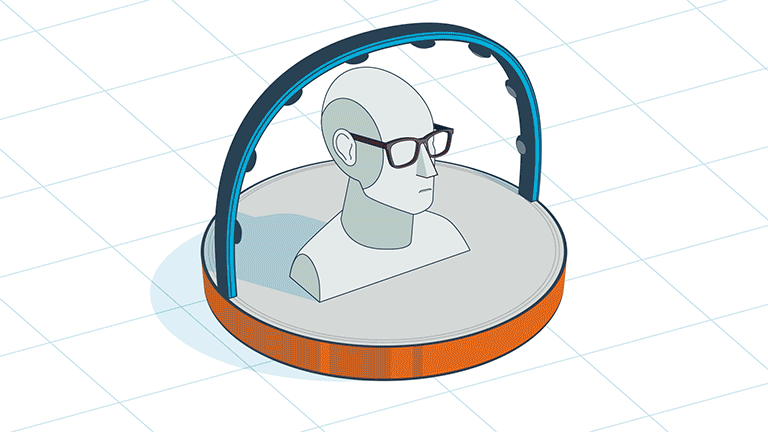When the team behind Amazon’s Echo Frames set out to improve the next generation of their product, they needed to strike a delicate balance. Customer feedback on earlier versions of the smart audio eyeglasses centered on three elements: longer battery life, more style options, and improved sound quality.

Achieving all three of those goals would be a challenge in itself; doing that inside the slim form factor of a pair of Alexa-enabled eyeglasses upped the ante.
“All three of those goals are in tension with one another,” says Adam Slaboski, senior manager of product management and product lead for Echo Frames. The easiest way to improve battery and audio would be to increase the size of the device, but that would conflict with feedback around the importance of design. Amping up bass to improve the audio experience would consume more battery, and so on.
Finding that sweet spot was a huge effort in engineering and customer understanding.
“Finding that sweet spot was a huge effort in engineering and customer understanding," Slaboski says.
With Echo Frames (3rd Gen) and Carrera Smart Glasses with Alexa (designed in collaboration with Safilo, one of the world’s leading eyewear companies), the Smart Eyewear team met the challenge.
The smart glasses feature enhanced audio playback, with custom-built speech-processing technology that dramatically improves word recognition — key for interacting with Alexa in windy or noisy environments. The new range of frame styles come in a variety of sizes, and all come with a significant boost in battery life.
From the outside, Echo Frames still look like a pair of regular eyeglasses. “But we changed everything on the inside,” says Jean Wang, general manager and director of Smart Eyewear. “And we learned new lessons along the way.”
Here’s how Amazon engineers and product designers tackled all three customer demands.
Turning up the volume with open-ear audio
Like previous generations of Echo Frames, the current model uses open-ear audio. In addition to fitting the form factor of a pair of glasses, this allows users to maintain awareness of their surroundings while interacting with Alexa or enjoying audio entertainment.
The open-ear audio design has been popular with users who are blind or have low vision, notes Jenai Akina, senior product manager for Echo Frames. “It’s really beneficial that it doesn’t obstruct a critical sense like hearing,” she explains. “That form factor is really helpful for daily interactions — especially when we want to be open to engage with our environment and the people around us. Open ear allows customers to maintain awareness, while providing access to a voice assistant.”
Open-ear audio brings a host of unique challenges to the engineering process. Typical headphones and earbuds block off the ear from the outside world, preventing air from escaping. That funnels more of the sound waves from the speakers into the user’s ears. With an open-ear design, sound has to travel farther, and there is less control over direction. That could lower the audio volume and reduce clarity — and importantly, audio could leak out to people standing nearby. The key is to drive the sound pressure as much as possible toward the user’s ears while minimizing the audio leakage.
By bringing people into the lab, we can simulate real environmental noise conditions like wind, background noise in a crowded restaurant, and the sound of cars on the road.
In working to improve audio quality, the team continued to hone the directionality of the sound while also working to improve volume and bass. A technique called dipole speaker configuration helps to do both. In addition to a sound porthole located near the ear canal, the frames feature a second porthole that cancels unnecessary sound while amping up bass.
With input from in-house audio experts and instruments to analyze measurements like harmonic distortion, the team came up with a set of potential tuning solutions that met objective targets for audio quality. They then tested those “flavors” of tuning in the lab with several user groups.
“By bringing people into the lab, we can simulate real environmental-noise conditions like wind, background noise in a crowded restaurant, and the sound of cars on the road,” explains senior manager of audio Scott Choi. That allowed his team to understand environmental variables in a controlled setting.
With the feedback from those focus groups, the team then selected a few of the most popular tunings to push out to beta testing, where users could provide feedback on a weekly basis.
“We see how the feedback trends change with each tuning change, which gradually allows it to mature and converge into a certain tuning,” Choi says. The result is audio calibrated to maximize intelligibility and volume without leaking private conversations (or guilty-pleasure playlists).

To test leakage, the audio team rigged up a rotating arch of microphones. The array moved in circles around a mannequin wearing the Gen 3 prototype, creating a 3-D sphere plot of audio leakage. Choi explains that they focused on minimizing leakage to the side and back, and ultimately, the speakers were moved much closer to the ear to help minimize leakage and improve loudness.
Leakage isn’t the only privacy consideration. The Echo Frame team also continues to innovate on protecting users from bad actors who may get hold of their smart glasses.
Gen 2 protected users by requiring them to authenticate their sessions using a trusted phone. Without authentication, a user can’t invoke sensitive commands like “navigate me home,” unlocking a smart lock, or making a purchase. But customers didn’t like the added friction.
Now customers who enroll in Alexa Voice ID will be able to use their vocal fingerprints for authentication to receive responses to smart-home utterances.
“We’re the first on-the-go Alexa device to use Voice ID for privacy authentication,” Slaboski says.
Boosting battery life without cramping style
Gen 3 improves continuous music playback time to six hours, versus the four hours offered by the previous generation of Echo Frames. It also bumps battery life to up to 14 hours of moderate usage spread across playback, talk time, notifications, and Alexa interactions.
Delivering the desired loudness, bass, and audio quality while optimizing for battery life was a careful balance.
The team couldn’t simply slap on a bigger battery without making the Echo Frames look less like normal glasses. And with sound quality high on the priority list as well, the devices were going to need as much juice as ever. The team focused on trimming power use in standby mode, ensuring that the overall battery consumption would go down without weakening the speakers when users needed them.
“Delivering the desired loudness, bass, and audio quality while optimizing for battery life was a careful balance,” says senior product manager Ravi Sanapala. “We need the battery to last throughout as much of the day as possible and for Alexa to be available whenever users need it.”
The architectural changes in speaker placement helped keep power needs low while improving audio. The team also tweaked the placement of the battery itself, distributing its capacity differently than in Gen 2. Sanapala adds that algorithmic changes were key in balancing idle-battery conservation and on-demand device usage.
“We had to collaborate with all of our cross-functional teams to optimize everything,” Sanapala says.
Gen 3 also features an all-new charging stand, which is designed for compatibility with all frame shapes and keeps lenses upright, protecting them from scratches while wirelessly charging.
Making smart eyewear look like eyewear
Making glasses that are suitable for everyday wear has always been a priority. “One of our goals has always been to develop technology that appears when you need it and disappears when you don’t,” says Wang.
Previous models of Echo Frames have come in a single, one-size-fits-all style.

“That was a very intentional move,” Wang explains. “We wanted to start simply and learn from customer feedback.”
Gen 2’s flexible spring hinge and adjustable temple tips ensured that the single size fit many different faces. In fact, Wang says, while the goal was to fit around half of all potential users, they’ve found that 85 percent of the adult population can comfortably wear the Gen 2 design.
But with Gen 3, Wang says, the team needed to go beyond designing glasses that looked typical. Customers wanted glasses that looked stylish, too.
The team consulted with both internal and external eyewear designers to review common and popular styles of frames, as well as “edgier” designs, and to survey potential customers about their preferences. After testing options with beta customers, they settled on a variety of styles in various colors that cover a range of aesthetics. They also switched to an acetate material to match the feel of high-end eyewear.
While each style will still come in a single size, the range of designs will accommodate even more faces than Gen 2, as the collection spans narrow, medium, and wide fits. Each style features adjustable temple tips constructed out of silicone around a lightweight titanium core for better fit. And despite the boost in battery life, the temples of Gen 3 frames have actually been slimmed down. Wang notes that competitive products often place large batteries behind a user’s ears. But presenting Echo Frames users with something that bulky and uncomfortable was never on the table.
“We were working with really heavy constraints,” Wang says. “So we have been very deliberate in making design choices in the service of our customer. That’s challenged us to be innovative and really push the limits of what’s possible in the architecture of our designs.”




















